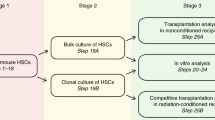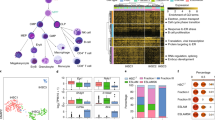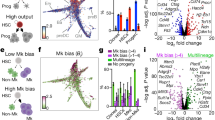Abstract
Hematopoiesis requires tight regulation of the hematopoietic stem cell (HSC) population; however, the dynamics of HSC use at steady state are uncertain. Over 3–7 months, we evaluated the repopulation and self-renewal of more than 600 individual human 'severe combined immunodeficiency mouse–repopulating cells' (SRCs), tracked on the basis of lentiviral integration sites, in serially transplanted immune-deficient mice, as well as of SRC daughter cells that migrated to different marrow locations in a single mouse. Our data demonstrate maintenance by self-renewing SRCs after an initial period of clonal instability, a result inconsistent with the clonal succession model. We found wide variation in proliferation kinetics and self-renewal among SRCs, as well as between SRC daughter cells that repopulated equivalently, suggesting that SRC fate is unpredictable before SRCs enter more rigid 'downstream' developmental programs.
This is a preview of subscription content, access via your institution
Access options
Subscribe to this journal
Receive 12 print issues and online access
$209.00 per year
only $17.42 per issue
Buy this article
- Purchase on Springer Link
- Instant access to full article PDF
Prices may be subject to local taxes which are calculated during checkout





Similar content being viewed by others
References
Kay, H.E. How many cell-generations? (Hypothesis). Lancet 1, 418–419 (1965).
Drize, N.J., Keller, J.R. & Chertkov, J.L. Local clonal analysis of the hematopoietic system shows that multiple small short-living clones maintain life-long hematopoiesis in reconstituted mice. Blood 88, 2927–2938 (1996).
Jordan, C.T. & Lemischka, I.R. Clonal and systemic analysis of long-term hematopoiesis in the mouse. Genes Dev. 4, 220–232 (1990).
Abkowitz, J.L. et al. Behavior of hematopoietic stem cells in a large animal. Proc. Natl. Acad. Sci. USA 92, 2031–2035 (1995).
Schmidt, M. et al. Polyclonal long-term repopulating stem cell clones in a primate model. Blood 100, 2737–2743 (2002).
Osawa, M., Hanada, K., Hamada, H. & Nakauchi, H. Long-term lymphohematopoietic reconstitution by a single CD34-low/negative hematopoietic stem cell. Science 273, 242–245 (1996).
Benveniste, P., Cantin, C., Hyam, D. & Iscove, N. Hematopoietic stem cells engraft in mice with absolute efficiency. Nat. Immunol. 4, 708–713 (2003).
Kiel, M.J. et al. SLAM family receptors distinguish hematopoietic stem and progenitor cells and reveal endothelial niches for stem cells. Cell 121, 1109–1121 (2005).
Till, J.E., McCulloch, E.A. & Siminovitch, L. A stochastic model of stem cell proliferation based on the growth of spleen colony-forming cells. Proc. Natl. Acad. Sci. USA 51, 29–36 (1964).
Lajtha, L.G. On the concept of the cell cycle. J. Cell. Comp. Physiol. 62, 143–145 (1963).
Humphries, R.K., Eaves, A.C. & Eaves, C.J. Self-renewal of hemopoietic stem cells during mixed colony formation in vitro. Proc. Natl. Acad. Sci. USA 78, 3629–3633 (1981).
Nakahata, T. & Ogawa, M. Identification in culture of a class of hemopoietic colony-forming units with extensive capability to self-renew and generate multipotential hemopoietic colonies. Proc. Natl. Acad. Sci. USA 79, 3843–3847 (1982).
Abkowitz, J.L., Catlin, S.N. & Guttorp, P. Evidence that hematopoiesis may be a stochastic process in vivo. Nat. Med. 2, 190–197 (1996).
Abkowitz, J.L., Golinelli, D., Harrison, D.E. & Guttorp, P. In vivo kinetics of murine hemopoietic stem cells. Blood 96, 3399–3405 (2000).
Kondo, M. et al. Biology of hematopoietic stem cells and progenitors:Implications for clinical application. Annu. Rev. Immunol. 21, 759–806 (2003).
Spangrude, G.J., Heimfeld, S. & Weissman, I.L. Purification and characterization of mouse hematopoietic stem cells. Science 241, 58–62 (1988).
Jones, R., Wagner, J., Celano, P., Zicha, M. & Sharkis, S. Separation of pluripotent haematopoietic stem cells from spleen colony-forming cells. Nature 347, 188–189 (1990).
Trevisan, M. & Iscove, N.N. Phenotypic analysis of murine long-term hemopoietic reconstituting cells quantitated competitively in vivo and comparison with more advanced colony-forming progeny. J. Exp. Med. 181, 93–103 (1995).
Christensen, J.L. & Weissman, I.L. Flk-2 is a marker in hematopoietic stem cell differentiation: a simple method to isolate long-term stem cells. Proc. Natl. Acad. Sci. USA 98, 14541–14546 (2001).
Morrison, S.J. & Weissman, I.L. The long-term repopulating subset of hematopoietic stem cells is deterministic and isolatable by phenotype. Immunity 1, 661–673 (1994).
Matsuzaki, Y., Kinjo, K., Mulligan, R.C. & Okano, H. Unexpectedly efficient homing capacity of purified murine hematopoietic stem cells. Immunity 20, 87–93 (2004).
Camargo, F.D., Chambers, S.M., Drew, E., McNagny, K.M. & Goodell, M.A. Hematopoietic stem cells do not engraft with absolute efficiencies. Blood 107, 501–507 (2006).
Ema, H. et al. Quantification of self-renewal capacity in single hematopoietic stem cells from normal and Lnk-deficient mice. Dev. Cell 8, 907–914 (2005).
McKenzie, J.L., Takenaka, K., Gan, O.I., Doedens, M. & Dick, J.E. Low rhodamine123 retention identifies long-term human hematopoietic stem cells within the Lin−CD34+CD38− population. Blood (in the press).
McKenzie, J.L., Gan, O.I., Doedens, M. & Dick, J.E. Human short-term repopulating stem cells are efficiently detected following intrafemoral transplantation into NOD/SCID recipients depleted of CD122+ cells. Blood 106, 1259–1261 (2005).
Wang, J.C. et al. in Hematopoiesis: A Developmental Approach (ed Zon, L.I.) 99–118 (Oxford University Press, New York, 2001).
Wang, J.C. & Dick, J.E. Cancer stem cells: lessons from leukemia. Trends Cell Biol. 15, 494–501 (2005).
Hogan, C.J., Shpall, E.J. & Keller, G. Differential long-term and multilineage engraftment potential from subfractions of human CD34+ cord blood cells transplanted into NOD/SCID mice. Proc. Natl. Acad. Sci. USA 99, 413–418 (2002).
Mazurier, F., Doedens, M., Gan, O.I. & Dick, J.E. Rapid myeloerythroid repopulation after intrafemoral transplantation of NOD-SCID mice reveals a new class of human stem cells. Nat. Med. 9, 959–963 (2003).
Glimm, H. et al. Previously undetected human hematopoietic cell populations with short-term repopulating activity selectively engraft NOD/SCID-beta2 microglobulin-null mice. J. Clin. Invest. 107, 199–206 (2001).
Kerre, T.C. et al. Both CD34+38+ and CD34+38− cells home specifically to the bone marrow of NOD/LtSZ scid/scid mice but show different kinetics in expansion. J. Immunol. 167, 3692–3698 (2001).
Guenechea, G., Gan, O.I., Dorrell, C. & Dick, J.E. Distinct classes of human stem cells that differ in proliferative and self-renewal potential. Nat. Immunol. 2, 75–82 (2001).
Mazurier, F., Gan, O.I., McKenzie, J.L., Doedens, M. & Dick, J.E. Lentivector-mediated clonal tracking reveals intrinsic heterogeneity in the human hematopoietic stem cell compartment and culture-induced stem cell impairment. Blood 103, 545–552 (2004).
Ailles, L. et al. Molecular evidence of lentiviral vector-mediated gene transfer into human self-renewing, multi-potent, long-term NOD/SCID repopulating hematopoietic cells. Mol. Ther. 6, 615–626 (2002).
Dao, M.A., Yu, X.J. & Nolta, J.A. Clonal diversity of primitive human hematopoietic progenitors following retroviral marking and long-term engraftment in immune-deficient mice. Exp. Hematol. 25, 1357–1366 (1997).
Piacibello, W. et al. Lentiviral gene transfer and ex vivo expansion of human primitive stem cells capable of primary, secondary, and tertiary multilineage repopulation in NOD/SCID mice. Nonobese diabetic/severe combined immunodeficient. Blood 100, 4391–4400 (2002).
Sieburg, H.B. et al. The hematopoietic stem compartment consists of a limited number of discrete stem cell subsets. Blood 107, 2311–2316 (2006).
Kustikova, O. et al. Clonal dominance of hematopoietic stem cells triggered by retroviral gene marking. Science 308, 1171–1174 (2005).
Woods, N.B., Bottero, V., Schmidt, M., von Kalle, C. & Verma, I.M. Gene therapy: therapeutic gene causing lymphoma. Nature 440, 1123 (2006).
Lemischka, I.R., Raulet, D.H. & Mulligan, R.C. Developmental potential and dynamic behavior of hematopoietic stem cells. Cell 45, 917–927 (1986).
Shepherd, B.E., Guttorp, P., Lansdorp, P.M. & Abkowitz, J.L. Estimating human hematopoietic stem cell kinetics using granulocyte telomere lengths. Exp. Hematol. 32, 1040–1050 (2004).
Abkowitz, J.L., Catlin, S.N., McCallie, M.T. & Guttorp, P. Evidence that the number of hematopoietic stem cells per animal is conserved in mammals. Blood 100, 2665–2667 (2002).
Yahata, T. et al. Clonal analysis of thymus-repopulating cells presents direct evidence for self-renewal division of human hematopoietic stem cells. Blood advance online publication 6 June 2006 (doi:10.1182/blood-2006-02-002204).
Ogawa, M. Differentiation and proliferation of hematopoietic stem cells. Blood 81, 2844–2853 (1993).
Madlambayan, G.J. et al. Dynamic changes in cellular and microenvironmental composition can be controlled to elicit in vitro human hematopoietic stem cell expansion. Exp. Hematol. 33, 1229–1239 (2005).
Ivanova, N. et al. Dissecting self-renewal in stem cells with RNA interference. Nature 442, 533–538 (2006).
Tanaka, T. et al. A novel monoclonal antibody against murine IL-2 receptor β-chain. Characterization of receptor expression in normal lymphoid cells and EL-4 cells. J. Immunol. 147, 2222–2228 (1991).
Herrbrich, P.E., Meyerrose, T.E., Wang, X., Ge, S. & Nolta, J.A. Development and characterization of the nude/NOD/SCID mouse: a novel xenograft recipient used to study long term human hematopoietic and mesenchymal stem cell engraftment. Blood. 100, abstract 2401 (2002).
Vormoor, J. et al. Immature human cord blood progenitors engraft and proliferate to high levels in severe combined immunodeficient mice. Blood 83, 2489–2497 (1994).
Acknowledgements
We thank P. Scheufler, P. Savage and the obstetrics unit of Trillium Hospital (Mississauga, Ontario) for providing cord blood samples; G. Mallia and S. Zere for processing cord blood samples; S. Zhao (Hospital for Sick Children, Toronto, Ontario) for sorting; and the Dick lab and N. Iscove for critical review of the manuscript. Supported by The Stem Cell Network of National Centres of Excellence; the National Cancer Institute of Canada with funds from the Canadian Cancer Society and the Terry Fox Foundation; Genome Canada through the Ontario Genomics Institute; Ontario Cancer Research Network with funds from the province of Ontario; the Leukemia and Lymphoma Society; the Canadian Institutes for Health Research; and Canada Research.
Author information
Authors and Affiliations
Contributions
J.L.M. and O.I.G. designed and did research, collected and analyzed data and wrote the paper; M.D. did research and collected data; J.C.Y.W. did research and wrote the paper; and J.E.D. designed research, analyzed data and wrote the paper.
Corresponding author
Ethics declarations
Competing interests
The authors declare no competing financial interests.
Supplementary information
Supplementary Fig. 1
Summary of the self-renewal properties of CD34+CD38lo and Lin− SRC. (PDF 103 kb)
Supplementary Fig. 2
Thirty-week multilineage engraftment from a mouse reconstituted by one transduced clone. (PDF 168 kb)
Rights and permissions
About this article
Cite this article
McKenzie, J., Gan, O., Doedens, M. et al. Individual stem cells with highly variable proliferation and self-renewal properties comprise the human hematopoietic stem cell compartment. Nat Immunol 7, 1225–1233 (2006). https://doi.org/10.1038/ni1393
Received:
Accepted:
Published:
Issue Date:
DOI: https://doi.org/10.1038/ni1393
This article is cited by
-
Clonal tracking using embedded viral barcoding and high-throughput sequencing
Nature Protocols (2020)
-
The hematopoietic stem-cell niche in health and leukemia
Cellular and Molecular Life Sciences (2017)
-
Homology-driven genome editing in hematopoietic stem and progenitor cells using ZFN mRNA and AAV6 donors
Nature Biotechnology (2015)
-
CD133-targeted Gene Transfer Into Long-term Repopulating Hematopoietic Stem Cells
Molecular Therapy (2015)
-
Discriminating cellular heterogeneity using microwell-based RNA cytometry
Nature Communications (2014)



